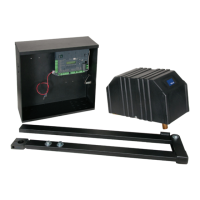6. Entrapment Protection
The UL325 standard for gate operators requires
a minimum of two independent entrapment
protection means for each entrapment zone. An
entrapment zone is defi ned as follows:
For slide gates, any locations between a moving
gate and a counter opposing edge or surface
where entrapment is possible up to a height of 6
ft. (1.83m) above grade. Such locations occur if at
any point in travel the gap between a moving gate
and the fi xed counter opposing edges or surfaces
is less than 16 in. (406mm).
For swing gates, locations between a moving
gate or moving, exposed operator components
and a counter opposing edge or surface where
entrapment is possible up to 6 ft (1.83m) above
grade. Such locations occur if during any point
in travel:
a. The gap between the bottom of a moving
gate and the ground is greater than 4 in.
(101.6 mm) and less than 16 in. (406 mm); or
The distance between the center line of the
pivot and the end of the wall, pillar, or column
to which it is mounted when in the open or
closed position exceeds 4 in. (101.6 mm).
Any other gap between a moving gate and
fi xed counter opposing edges or surfaces
or other fi xed objects is less than 16 in. (406
mm) (examples are walls, curbs, berms or
other immovable objects).
Potential entrapment zones are shown below
for swing gates, but keep in mind there may be
other entrapment zones presented by the actual
installation and adjacent structures or landscape
that must be protected as well.
Swing Gate Possible Entrapment Zones
Open
Direction
Eye
Open
Direction
Eye
Outside
Gate
Close Direction Eye
Possible Entrapment Zones - Typical Installation Diagram Utilizing Photocells
(Installer must assess site for any other entrapment risks)
Close Direction Eye
Open
Direction
Eye
Open
Direction
Eye
(Possible Entrapment Zone
if gate opens to <16 inches
from wall or fixed object)
(Possible Entrapment Zone
if gate opens to <16 inches
from wall or fixed object)

